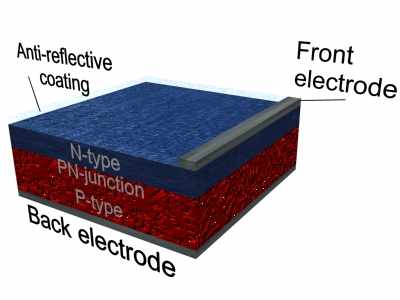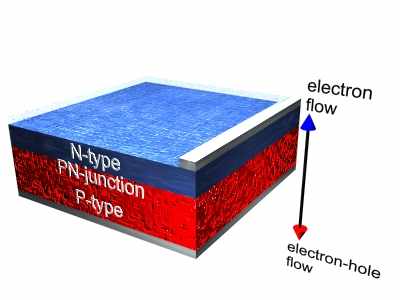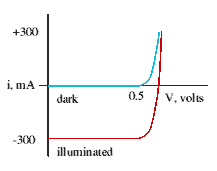


HOW DO SOLAR CELLS WORK?

IMAGE - A cross section of a solar cell
A conventional solar cell comprises of a N-type and a P-type material sandwiched together.
A typical silicon solar cell is made from p-type silicon semiconductor which is silicon which has been doped by introducing a small amount of an element such as B, Al, In or Ga from Group III of the Periodic Table. Then a thin layer of about 1 micrometre thickness on the top surface is converted into n-type semiconductor by diffusing in a Group V element (As, P, Sb). Where this layer joins the p-type material there is a p-n junction, which has an electric field across it. Electrodes are formed on the top and bottom surfaces of the cell, that on the top being made so that light can pass through it. These electrodes are used to connect the cell into the solar array.
When sunlight is shone on the top surface of the cell, photons in the sunlight (link to Photons and Atomic Spectra) pass into the n-type layer and a proportion of them is absorbed, giving rise to pairs of electrons and positively charged holes. These move in opposite directions because of the electric field in the junction-- the electrons to the n-type material and the holes to the p-type. The motions of these charges cause an electric current to flow in the external circuit.

IMAGE - A working solar cell
When light is incident on the solar cell, electrons flow towards the N-type material. Conversely, the electron holes flow towards the P-type material. This produces a current which can be used to power an external load

The p-n junction is an electrical diode. If it is not illuminated and the electrode connected to the p-type material is made positive, only a very tiny current will flow through the cell. However, when it is illuminated, a large current will flow whose amount depends on the intensity of the light. A 20mm by 40mm cell in full sunlight will generate a current of about 300 mA at a potential of 0.53 V corresponding to a power efficiency of 15%.
Whilst silicon cells are the variety generally used, they are not the only kind available. Gallium arsenide cells have a higher efficiency but are more expensive. The cost is coming down however and no doubt they will come into use in due course.
Return to Solar Arrays.

